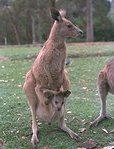Among the
mammals, there are three major variations in reproductive systems. This
is the basis for dividing them into subclasses and infraclasses.
| class: | Mammalia | ||
|---|---|---|---|
| subclass: | Prototheria | Theria | |
| infraclass: | Metatheria | Eutheria | |
Members of
the subclass Prototheria
![]() lay eggs
like most non-mammalian vertebrates. However, they feed their newborn with mammary gland secretions like all other mammals.
They lack nipples, but the skin over their mammary glands exude milk for
their babies. The
Prototheria are also referred to
as monotremes
lay eggs
like most non-mammalian vertebrates. However, they feed their newborn with mammary gland secretions like all other mammals.
They lack nipples, but the skin over their mammary glands exude milk for
their babies. The
Prototheria are also referred to
as monotremes
![]() , which literally means that they
have one opening for excretion and reproduction. This is similar to
birds and reptiles. The
Prototheria are also similar to reptiles in some aspects of their
skeletons. Notably, their legs are on the sides of their bodies rather
than underneath them. This results in a reptile-like gait.
There are only three surviving rare
species groups of Prototheria. These are the Australian platypus and 2
echidna (spiny anteater) species of Australia and New Guinea.
, which literally means that they
have one opening for excretion and reproduction. This is similar to
birds and reptiles. The
Prototheria are also similar to reptiles in some aspects of their
skeletons. Notably, their legs are on the sides of their bodies rather
than underneath them. This results in a reptile-like gait.
There are only three surviving rare
species groups of Prototheria. These are the Australian platypus and 2
echidna (spiny anteater) species of Australia and New Guinea.
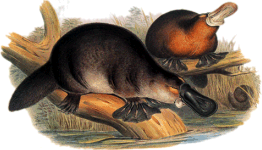 |
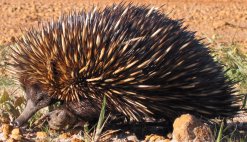 |
|
|
Platypus (subclass Prototheria) |
Echidna (subclass Prototheria) |
Genome of the Platypus--video clip from Nature.com
(length = 7 mins. 30 secs.)
To find out a little more about the strange lives of monotremes, select the "Echidna Reproduction" button below:
All other
living mammalian species, including humans, are in the subclass
Theria
![]() .
They have in common the fact that they give birth to live young. Therian
mammals apparently did not evolve from the Prototheria. The relatively primitive
prototherian reproductive system evidently evolved after their evolutionary line separated
from the other early mammals.
.
They have in common the fact that they give birth to live young. Therian
mammals apparently did not evolve from the Prototheria. The relatively primitive
prototherian reproductive system evidently evolved after their evolutionary line separated
from the other early mammals.
The oldest infraclass of therian mammals is the Metatheria
![]() , or the
marsupials
, or the
marsupials
![]() .
Their young are born very immature and cannot live without further development
in the mother's pouch. The word marsupial comes from
marsupium, the Latin word for purse. Marsupials include kangaroos, koalas,
opossums, and many other similar animals. Most of them are native only to Australia
and New Guinea.
.
Their young are born very immature and cannot live without further development
in the mother's pouch. The word marsupial comes from
marsupium, the Latin word for purse. Marsupials include kangaroos, koalas,
opossums, and many other similar animals. Most of them are native only to Australia
and New Guinea.
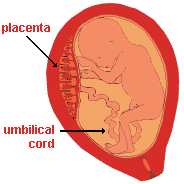 |
|
| Human fetus in utero |
Most mammal
species, including humans, are in the infraclass Eutheria
![]() . They are
also referred to as placental
. They are
also referred to as placental ![]() mammals. Eutherian mothers carry their unborn children within the uterus where they are
nourished and protected until an advanced stage is reached.
This is made possible by the umbilical
cord and placenta which connects the fetus to the uterus wall and enables
nutrients and oxygen to get to the offspring as well as provides a means of eliminating
its waste. At the same time, the placenta
functions as a barrier to keep the blood cells and other components of the
immune systems of the mother and her fetuses separate to prevent their
destruction.
mammals. Eutherian mothers carry their unborn children within the uterus where they are
nourished and protected until an advanced stage is reached.
This is made possible by the umbilical
cord and placenta which connects the fetus to the uterus wall and enables
nutrients and oxygen to get to the offspring as well as provides a means of eliminating
its waste. At the same time, the placenta
functions as a barrier to keep the blood cells and other components of the
immune systems of the mother and her fetuses separate to prevent their
destruction.
Giant pandas are an exception among the placental mammals. Their babies are born at only 1/4 the size predicted for the general placental mammal pattern. Marsupial babies are born at an even more immature stage because their rudimentary placentas are comparatively inefficient in nurturing fetuses.
Placental mammals have been extremely successful in out-competing monotremes and marsupials for ecological niches. This is mostly due to the fact that their babies are born more mature, which increases their chances of survival. This is particularly true of herbivores that are predated on by carnivores. Marsupials give birth to early stage fetuses. Placental mammals give birth after fetuses are much more developed. The downside is that pregnant placental mammals must consume significantly more calories to nurture their fetuses and themselves, especially during the second half of their pregnancies. Like monotremes and marsupials, placental mammals feed their babies with milk from their mammary glands. Species that have multiple births at the same time generally have more mammary glands. The number ranges from 2 in primates, goats, sheep, and horses to 18 in pigs.
Placental mammals are found on all continents, in the air, and in the seas. Primates, cats, dogs, bears, hoofed animals, rodents, bats, seals, dolphins, and whales are among the dominant placental mammal groups today. Nearly 94% of all mammal species now are placental mammals (5,080 species out of 5,416).
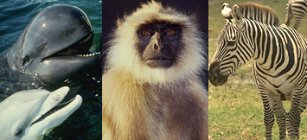 |
| Whale, dolphin, monkey, and zebra (infraclass Eutheria) |
The next tutorial in this series, The Primates, investigates all of the Linnaean classification categories below the infraclass level for humans, apes, monkeys, and some other closely related animals. This will take us from the "order" level down to "species."
NEWS: A team of researchers led by Wesley Warren at Washington University School of Medicine reported their completion of a draft of the platypus genome sequence in the May 8, 2008 issue of the journal Nature. This showed that the platypus has about 18,500 genes (about 2/3 as many as humans) and that 82% are shared with humans, mice, dogs, opossums, and chickens. Other platypus genes show links to reptiles, including those related to egg-laying, vision, and venom production. Adult male platypuses can inject their poison with a spur just above the heel of each hind foot. Apparently, they use this as a weapon against other males during the mating season. Platypuses are also unusual in having sensors in their bills that are used to detect faint electrical fields from their prey when they hunt them under water.
NEWS: The results of a 5 year global project sponsored by the Union for Conservation of Nature to survey all living mammals has been completed. The researchers concluded in October 2008 that one half of the 5487 mammal species are declining in numbers and at least 1/4 are now threatened with extinction due primarily to habitat destruction, hunting by humans, and climate change (Jan Schipper et al., Science 1165115, 2008).
